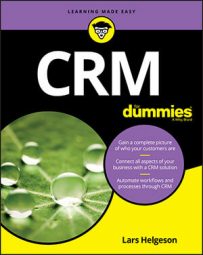- Email marketing: Newsletters, transactional emails, drip campaigns, form auto-responders. Emails sent, read, clicked, bounced, and unsubscribed should all flow automatically into your CRM.
- Website analytics: More than a summary of the number of website visitors, you want to know exactly who was on your site, what pages they were on, and for how long. This information should be accessible when looking at a contact record, or in daily, weekly, and monthly reports.
- Website management (CMS) and landing pages with Personalized URLs and A/B split testing: Your websites and landing pages are an important part of the conversion process, so be sure you can customize page content for each visitor and test which strategies work best. Ideally, your A/B split tests should automatically adjust to route traffic to the best performing webpages.
- Lead capture forms: Forms should be easy to build and should collect data that feeds directly into your CRM. Automate follow-up activities, and use progressive profiling (identifying when known contacts are on your form and pre-filling fields you already have data for). Employ automatic lead research tools to append data you don't have, and assess lead risk based on IP address and email address to help your salespeople be more efficient.
- Campaign tracking: When you drive people to your websites and landing pages, identify them by a campaign ID. Use those campaign IDs to segment your market and identify which campaigns are working best. View how your campaigns impact interaction with your brand.
- Surveys: Send surveys to your contacts and have the results automatically attached to the contact record. Score surveys so you can automate and customize follow-ups.
- Social: Connect contacts to their social media profiles. Set up automation to interact with a lead when he or she interacts with you on a social media site.
- Customer service/ticketing: Set up ticketing forms on your website for managing customer inquiries and sales leads.
- Live chat: If it makes sense for your business and you have the manpower to staff it, install live chat on your website and have those conversations automatically added to your CRM.
- Event management. Hosting events, parties, conferences, and meetings, both for your team and for your leads, should be easy and the attendance should be stored in your CRM. If you do recurring events, use past attendee and sponsor data to target return visitors.
- Opportunity management: If you sell to businesses, be sure your CRM tracks complex opportunities with different products, values, and dates associated with the opportunity. Forecast sales and hold your team accountable to meeting quotas. Automate what happens when leads hit specific points in the opportunity development process.
- Document management and digital signing: Create document templates that can be used for building proposals and contracts. Allow those templates to be attached to contact or company records and sent for digital signature. Automate that process with workflows where possible.
- Marketing automation: Set up rules that trigger automatic actions. An easy-to-use drag-and-drop interface should allow you to specify what happens when a lead or contact does something, or fails to do something. Automation should span across all parts of your business.
- Learning management: When new employees come on board, have them go through a defined learning experience. Test them for competency and have the results logged in your CRM. This proves competency and legal sufficiency for them having received required training.
- Knowledge management: Give your team access to a knowledge base they can contribute to. Create a searchable knowledge base that you can publish for public consumption to cut down on support inquiries.
- Contact research: Search public sources for information about your leads and clients. Append data whenever possible to your CRM so you can accumulate more information.
- SMS and voice integration: When your staff calls or receives calls, that information should be stored in the CRM. Ideally, you want to have recordings of those calls and transcriptions, as well. Set up a phone tree that routes calls to the right people, automatically recording that call and attaching it to the contact record.
- Lead scoring: Use a scoring system to evaluate your leads both demographically and behaviorally. Be sure to decay your activity-generated points over time for best accuracy.
- Predictive analytics: Build a model that shows the statistical correlation between demographics and activities and conversions. Apply that model to leads, so you can identify the contacts most likely to convert, and have your salespeople target them.

